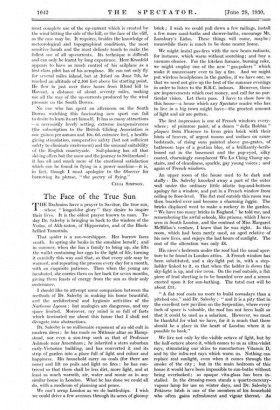Silent Flight
CLIMBING up the Beacon Hill from South Harting, near Petersfield, through the grounds of Mr. Bertrand Russell's school, I saw a strange apparition darting behind a tree—a boy trailing an orange blanket from his shoulders, valiantly impersonating a glider. Sliding down the banisters, bumping down the stairs on a tea-tray, running headlong down a hill, or ski-ing down the slopes of the Wengcrn, probably all serve the same purpose—namely, to satisfy our common desire to fly. For surely most of us have dreamt, either by day or by night, of flying. It is therefore comforting and stimulating that in this twentieth century our dream should come true. Flying in an aeroplane is exhilarating and intensely interesting, but flying in a glider, or, better still, in a sailplane, must be an even greater delight, for the thundering of a 425 h.p. engine (or rather three 425 h.p. engines) is not a necessary appurtenance of our flying dreams.
And the flying of this newly perfected type of aircraft seems to be a simple matter. The glider or sailplane is partly carried and partly wheeled on a trolley to the top of the hill, with its nose facing the wind. When the surging, curious crowd has eventually been persuaded to line up on either side, a rubber rope with two ends is attached to a hook on the nose of the plane. Each end is held by from three to nine men, according to the skill of the pilot and the strength of the wind. Two men hold down the tail of the plane. The pilot settles himself in his cockpit, and as he shouts the words " Walk : Run : Release ! " the men run forward and outwards down the hill, and the plane is silently launched into the air. There is no roar of engines, no rush of wind. The silence is extraordinary and most impressive.
On Saturday and Sunday when I went to Beacon Hill, the wind was neither strong enough, nor from the right direction, for Herr Kronfeld, the famous Austrian soaring pilot, who has come over to England to assist the British Gliding Association, to demonstrate his amazing soaring feats. The weather conditions were only suitable for gliding. He therefore spent much of his time initiating new members of the rapidly growing number of Gliding Clubs into the joys of this new sport. With smiling faces—apparently quite unperturbed, and justifiably so —I saw several men make their first attempt to glide in the glider known as the Zogling (pupil), which is the safest and most robust type of glider. I must admit that all they had to do was to sit in the cockpit, holding the joystick with one hand, and leave the glider to its sweet will, for beginners are not encouraged to rise more than the two or three feet from the ground, which the glider will probably do of its own accord. When the beginner has passed his first test, which entails a straight flight from the top of the hill to the bottom, of thirty seconds' duration, he is probably allowed to try his hand in the Prilffing (intermediate) type of glider, which is not only capable of gliding, but also to a limited extent of soaring. Herr Magersuppe gave a beautiful gliding exhibition in 'The Professor '—a blue high-performance craft with The Daily Express written across it. Three weeks ago, as I was walking up the north side of Fine Beacon, near Lewes, I saw this lovely creature hovering almost motionless like a seagull over the cornfields in the valley, rippling in the wind like the waves of the sea.
But it is Herr ICronfeld in his delicate and graceful sail- plane, 'The Vienna,'—an immense, golden dragon fly with transparent veined wings—who achieves the most amazing feats. For gliding seems comparatively easy to do, and scientifically comprehensible. But soaring is a very different matter. It is only achieved by making the most complete use of the up-current which is created by the wind hitting the side of the hill, or the face of the cliff, as the case may be. It requires, besides the -knowledge of meteorological and topographical conditions, the most sensitive hands and the most delicate touch to make the fullest use of all up-currents. Its technique is difficult and can only be learnt by long experience. Herr Kronfeld appears to have as much control of his sailplane as a first-class pilot has of his aeroplane. He can not only fly for several miles inland, but at Itford on June 7th, he reached an altitude of 2,500 feet above his starting point. He flew in just over three hours from Itford hill to Havant, a distance of about seventy miles, making use all the way of the up-currents produced by the wind pressure on the South Downs.
No one who has spent an afternoon on the South Downs watching this fascinating new sport can fail to desire to learn its art himself. It has so many attractions —a necessarily lovely setting, extreme inexpensiveness (the subscription to the British Gliding Association is one guinea per annum and 10s. 6d. entrance fee), a health- giving stimulation, comparative safety (but not sufficient safety to eliminate excitement) and the unusual suitability of the English countryside. Sail-planing has all that ski-ing offers but the snow and the journey to Switzerland : it has all and much more of the emotional satisfaction which can be found in flying in a power machine—it is, in fact, though I must apologize to the Observer for borrowing its phrase, "the poetry of flying."
CELIA SIMPSON.



















































 Previous page
Previous page